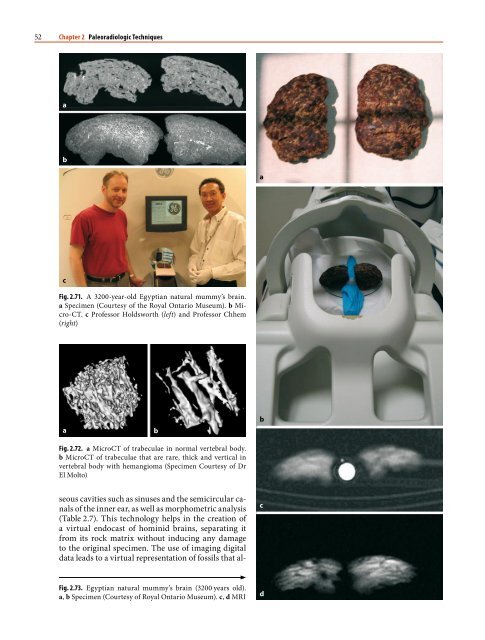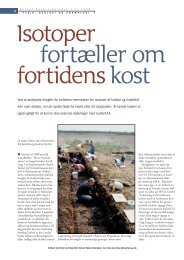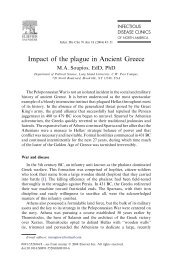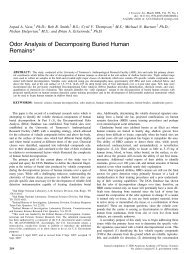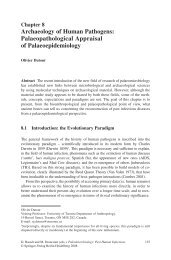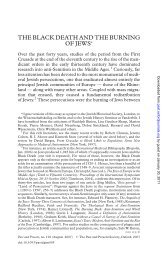1 Paleoradiology: History and New Developments - Academia.dk
1 Paleoradiology: History and New Developments - Academia.dk
1 Paleoradiology: History and New Developments - Academia.dk
You also want an ePaper? Increase the reach of your titles
YUMPU automatically turns print PDFs into web optimized ePapers that Google loves.
material strips). The strips are arranged to transmit<br />
only the x-rays directed toward the receptor that have<br />
not been scattered. One disadvantage of using a grid<br />
for medical applications is increased x-ray dose to the<br />
patient, as a higher tube currents <strong>and</strong> exposure times<br />
are required to make up for the x-rays lost to the grid.<br />
A disadvantage applicable to bioarcheological applications<br />
is the production of grid lines on the radiographic<br />
film, caused by the absorption of x-rays by the<br />
grid. This is a shortcoming that can be minimized by<br />
use of a reciprocating grid, which moves back <strong>and</strong><br />
forth rapidly throughout the x-ray exposure, thereby<br />
decreasing grid lines (Bushong 2004).<br />
2.2.4.2<br />
Radiographic Film<br />
An image receptor is any medium that converts incident<br />
x-rays into an image. Film remains the most<br />
commonly used image receptor in radiography, although<br />
it is largely being replaced by computed <strong>and</strong><br />
digital radiography (CR <strong>and</strong> DR, respectively) in the<br />
hospital environment (see sections 2.4.1 <strong>and</strong> 2.4.2, respectively).<br />
Most radiographic film consists of a base,<br />
which causes the film to be rigid, <strong>and</strong> an emulsion<br />
layer on both sides. The emulsion layer is a mixture<br />
of gelatin <strong>and</strong> silver halide crystals; this is the part of<br />
the film that creates the image. The main purpose of a<br />
dual emulsion film is to limit patient dose, a consideration<br />
less important for bioarcheological specimens.<br />
Most radiographic films are used in conjunction with<br />
an intensifying screen, a sheet of crystals of inorganic<br />
salts (phosphors) that emit fluorescent light when excited<br />
by x-rays. This serves to intensify the effect of<br />
x-rays during exposure of the radiographic film. Figure<br />
2.6 is a schematic cross-section of a screen-film<br />
image receptor. For portability <strong>and</strong> durability, these<br />
are usually permanently mounted in cassettes (Bushong<br />
2004).<br />
When selecting a film-screen combination for bioarcheological<br />
radiography, it is important to consider<br />
the film speed. The faster the speed of the film, the<br />
thicker it will be, allowing for improved x-ray absorption<br />
<strong>and</strong> reduction in the necessary x-ray dose. However,<br />
this benefit is not as critical for bioarcheological<br />
specimens <strong>and</strong> it comes at the expense of resolution,<br />
therefore slow speed (thinner) film is optimal. Other<br />
important parameters to consider are single-emulsion<br />
films, to maximize resolution, <strong>and</strong> uniform small<br />
crystal size in the intensifying screen to provide high<br />
contrast <strong>and</strong> maximum resolution.<br />
2.2 Radiographic Production<br />
Fig. 2.6. Simplified cross-section of a screen-film image receptor<br />
system. The phosphor screens serves to absorb x-rays <strong>and</strong><br />
emit visible light photons, which is recorded on the film emulsions.<br />
The emulsion-base-emulsion layers comprise the film<br />
Proper h<strong>and</strong>ling <strong>and</strong> storage of radiographic film<br />
is very important. Film should be kept free of dirt,<br />
<strong>and</strong> bending <strong>and</strong> creasing films should be strictly<br />
avoided. The film is sensitive to light <strong>and</strong> radiation,<br />
so it must be stored <strong>and</strong> h<strong>and</strong>led in the dark, away<br />
from sources of radiation, such as the x-ray imaging<br />
system. The storage area should also be dry <strong>and</strong> cool,<br />
preferably less than 20°C (68 F).<br />
2.2.5<br />
Geometry Factors<br />
The geometric arrangement of x-ray equipment is an<br />
important determinant for image quality. Geometry<br />
factors include the size of the focal spot <strong>and</strong> its distance<br />
from the object <strong>and</strong> image receptor.<br />
2.2.5.1<br />
Focal Spot Size<br />
Most general x-ray tubes are equipped with a small<br />
<strong>and</strong> a large focal spot. Recall from section 2.2.1 that<br />
the focal spot is the x-ray source, the area on the anode<br />
where the electron beam interacts to produce xrays.<br />
A small focal spot provides greater image detail<br />
than its large counterpart because it casts the smallest<br />
penumbra, which is the area of blur at the edge of<br />
the image (Schueler 1998) (Fig. 2.7). One might wonder<br />
when a large focal spot would be ever required.<br />
It is used because the greater surface area for x-ray<br />
production minimizes heat production <strong>and</strong> the risk<br />
19


